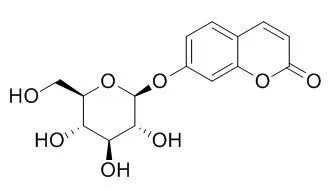| In vitro: |
| Bioimpacts. 2014;4(4):191-8. | | Geno/cytotoxicty and Apoptotic Properties of Phenolic Compounds from the Seeds of Dorema Glabrum Fisch. C.A.[Pubmed: 25671175 ] | Dorema glabrum (Apiaceae) is a rare and monocarpic species distributed in Transcaucasia and North West of Iran. We aimed to explore anti-cancer potency of bioactive compounds from the seeds of Dorma glabrum.
METHODS AND RESULTS:
Methanol extract was subjected to phytochemical investigation using normal phase Sep-pak and reversed-phase HPLC, and cytotoxic effect of isolated compounds on CAOV-4 cell line was evaluated. Furthermore, Annexin V/PI staining and comet assay were used to study genotoxicity of compounds.
Diglucosyl caffeoyl ester (1), Glucopyranosylcaffeic acid (2) and Skimmin (3), were identified. MTT cytotoxicity assay showed growth inhibition of CAOV-4 cells due to treatment with compunds (1), (2) and (3) with an IC50 of 99.7, 87.3 and 70.03 μg/ml at 48 h, respectively. Annexin V-FITC/PI staining showed occurrence of early/late apoptosis in the (1)-treated cells, while (2)-and (3)-treated cells necrosis/late apoptosis was dominant event. Single/double strands DNA breakages were observed by comet assay in all treatments.
CONCLUSIONS:
This work provides sufficient information about anti-cancer properties of the diglucosyl caffeoyl ester from the seeds of D. glabrum. |
|
| In vivo: |
| Eur J Pharmacol. 2012 Oct 5;692(1-3):78-83. | | Skimmin, a coumarin, suppresses the streptozotocin-induced diabetic nephropathy in wistar rats.[Pubmed: 22664227] | Skimmin, a major active ingredient from Hydrangea paniculata, was considered to have the possible preventive effect on the progression of diabetic nephropathy based on the traditional Chinese medicine. The present study aimed to assess this preventive activity in a rat model of diabetic nephropathy.
METHODS AND RESULTS:
Adult wistar rats were induced to develop diabetic nephropathy through injection of streptozotocin (60mg/kg). Animals were treated orally with saline, Skimmin at 7.5, 15 and 30mg/kg, and losartan (10mg/kg) daily for 17 weeks. At 7 and 17 weeks, blood and urine samples were collected for biochemical examination; at the end of 17 weeks, all the kidney tissues were collected for the histological examination. Enzyme-linked immunosorbent assay (ELISA) and reverse transcription polymerase chain reaction (RT-PCR) were used to analyze the expression of transforming growth factor-beta 1(TGF-β1) and its receptors in blood and kidney tissues respectively. Our results suggested that Skimmin could decrease the Scr and glucose level in blood of diabetic rats significantly (P<0.01), and increase the creatinine clearance (P<0.01), similar changes were also observed in the losartan-treated rats. In histological examination, Skimmin-treated rats showed a significant decrease in glomcrulus segmented sclerosis and incidence of tubule vacuolar degeneration (P<0.01), similar but less significant beneficial effects were observed for losartan treatment. By ELISA, western blotting and RT-PCR, we found Skimmin could down-regulate the TGF-β1 and TGF-β Receptor I expression both at protein and mRNA levels.
CONCLUSIONS:
This study suggests that the Skimmin can suppress diabetic nephropathy in rats effectively, and may slow down the renal fibrosis by regulating TGF-β1 signal pathway. |
|






 Cell. 2018 Jan 11;172(1-2):249-261.e12. doi: 10.1016/j.cell.2017.12.019.IF=36.216(2019)
Cell. 2018 Jan 11;172(1-2):249-261.e12. doi: 10.1016/j.cell.2017.12.019.IF=36.216(2019) Cell Metab. 2020 Mar 3;31(3):534-548.e5. doi: 10.1016/j.cmet.2020.01.002.IF=22.415(2019)
Cell Metab. 2020 Mar 3;31(3):534-548.e5. doi: 10.1016/j.cmet.2020.01.002.IF=22.415(2019) Mol Cell. 2017 Nov 16;68(4):673-685.e6. doi: 10.1016/j.molcel.2017.10.022.IF=14.548(2019)
Mol Cell. 2017 Nov 16;68(4):673-685.e6. doi: 10.1016/j.molcel.2017.10.022.IF=14.548(2019)